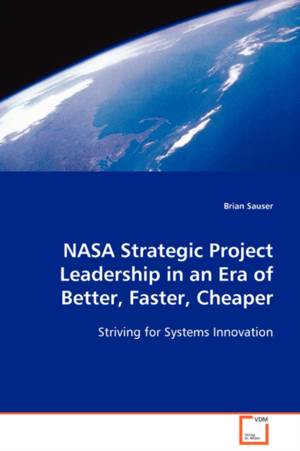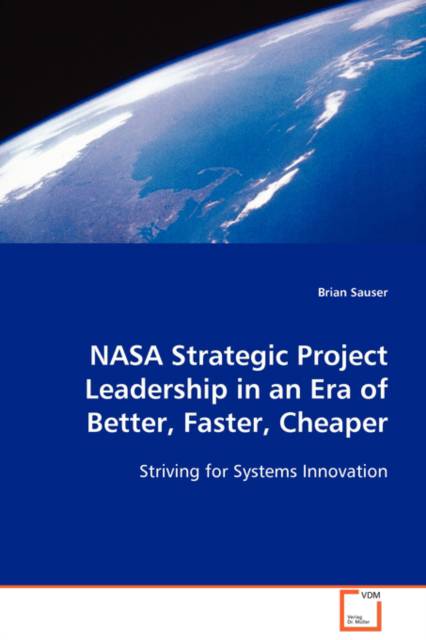
- Afhalen na 1 uur in een winkel met voorraad
- Gratis thuislevering in België vanaf € 30
- Ruim aanbod met 7 miljoen producten
- Afhalen na 1 uur in een winkel met voorraad
- Gratis thuislevering in België vanaf € 30
- Ruim aanbod met 7 miljoen producten
Zoeken
NASA Strategic Project Leadership in an Era of Better, Faster, Cheaper
Striving for Systems Innovation
Brian Sauser
Paperback | Engels
€ 115,95
+ 231 punten
Omschrijving
Space science projects in NASA are typically
characterized by advanced technology, new types of
missions,
complex
integration of hardware and software systems, and
inflexible time
frames that are often dictated by launch windows.
To analyze
these
types of projects, this investigation used the
framework of
Strategic Project Leadership (SPL) correlated with
systems
development projects through case study research.
Four NASA
projects were investigated that were managed during
an era within
NASA of Better, Faster, Cheaper (BFC). Two of them
were successes
(Mars Pathfinder and Lunar Prospector), and two
failures (CONTOUR
and Mars Climate Orbiter). The objectives of this
study were to (1)
develop a better conceptual understanding of
strategic system
innovation through the study of BFC projects, (2)
understand how
SPL can describe BFC projects, and (3) provide
feedback,
recommendations, and lessons learned to NASA and the
aerospace
industry on potential success criteria for BFC
projects.
characterized by advanced technology, new types of
missions,
complex
integration of hardware and software systems, and
inflexible time
frames that are often dictated by launch windows.
To analyze
these
types of projects, this investigation used the
framework of
Strategic Project Leadership (SPL) correlated with
systems
development projects through case study research.
Four NASA
projects were investigated that were managed during
an era within
NASA of Better, Faster, Cheaper (BFC). Two of them
were successes
(Mars Pathfinder and Lunar Prospector), and two
failures (CONTOUR
and Mars Climate Orbiter). The objectives of this
study were to (1)
develop a better conceptual understanding of
strategic system
innovation through the study of BFC projects, (2)
understand how
SPL can describe BFC projects, and (3) provide
feedback,
recommendations, and lessons learned to NASA and the
aerospace
industry on potential success criteria for BFC
projects.
Specificaties
Betrokkenen
- Auteur(s):
- Uitgeverij:
Inhoud
- Aantal bladzijden:
- 208
- Taal:
- Engels
Eigenschappen
- Productcode (EAN):
- 9783639099386
- Verschijningsdatum:
- 12/11/2008
- Uitvoering:
- Paperback
- Formaat:
- Trade paperback (VS)
- Afmetingen:
- 152 mm x 229 mm
- Gewicht:
- 285 g

Alleen bij Standaard Boekhandel
+ 231 punten op je klantenkaart van Standaard Boekhandel
Beoordelingen
We publiceren alleen reviews die voldoen aan de voorwaarden voor reviews. Bekijk onze voorwaarden voor reviews.








